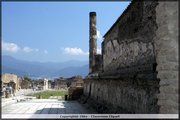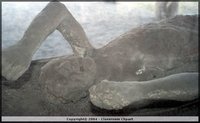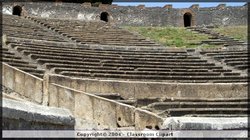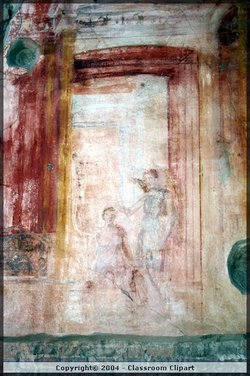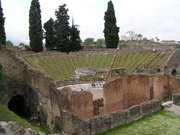Pompeii
|
|
The city of Pompeii, along with Herculaneum and many smaller places around the Bay of Naples, were Roman municipalities destroyed during an eruption of the volcano Mount Vesuvius in 79 CE. The eruption was described by Pliny the Younger (see below), whose uncle Pliny the Elder died after travelling across the bay with a flotilla of naval vessels to save some of those trapped in the seaside towns.
| Contents |
Early History
The town was founded in the ca. 6th century BCE by the Osci or Oscans, a people of central Italy, on a hill near the mouth of the Sarno River or Sarnus River, already in use as a safe port by Greek and Phoenician sailors. When Etruscans threatened an attack, Pompeii allied with the Greeks, who then dominated the Gulf of Naples. In the 5th century BCE, the Samnites conquered it (and all the other towns of Campania); the new rulers imposed their architecture and enlarged the town. It has been supposed that during the Samnites' domination, Rome conquered Pompeii for a while, but these theories have not been verified.
Pompeii took part in the war that the towns of Campania initiated against Rome, but in 89 BCE it was besieged by Sulla. Although the troops of the Social League, headed by Lucius Cluentius, helped in resisting the Romans, in 80 BCE Pompeii was forced to surrender after the conquest of Nola. It became a Roman colony with the name of Colonia Cornelia Veneria Pompeianorum. The town became an important passage for goods that arrived by sea and had to be sent toward Rome or Southern Italy along the nearby Appian Way.
In 62, a violent earthquake severely damaged Pompeii and many other towns of Campania. In the time between 62 and 79 (the eruption), it was rebuilt, perhaps richer than before in houses and artworks.
Vesuvius buries the city
The inhabitants of Pompeii, as those of the area today, had long been used to minor tremors and wisps of gas from Mt. Vesuvius, and in 62 there had been a series of earthquakes serious enough to cause structural damage to houses in town; and in early August of 79, all the town's wells dried up; but the warnings were not sharp enough, and the Roman world was stunned when on August 24 a catastrophic volcanic eruption of the volcano buried the city and obscured the sun on a mild afternoon. Coincidentally, the date was that of the Vulcanalia, the festival of the Roman god of fire.
The only reliable eyewitness account of the event was recorded by Pliny the Younger in a letter to the historian Tacitus. Pliny saw a strange phenomenon occurring over Mt. Vesuvius: a large dark cloud shaped rather like a pine tree emanating from the mouth of the mountain. After some time the cloud rushed down the flanks of the mountain and covered everything around it, including the surrounding sea.
The "cloud" that Pliny the Younger wrote about is known today as a pyroclastic flow, which is a cloud of superheated gas, ash, and rock that erupts from a volcano. Pliny stated that several earth tremors were felt at the time of the eruption and were followed by a very violent shaking of the ground. He also noted that ash was falling in very thick sheets and the village he was in had to be evacuated. Also, the sea was sucked away and forced back by an "earthquake", a phenomenon which modern geologists call a tsunami.
His description then turned to the fact that the sun was blocked out by the eruption and the daylight hours were left in darkness. His uncle Pliny the Elder had already taken several ships to investigate the phenomenon. On the other shore, Pliny the Elder apparently died from carbon dioxide asphyxiation after lying on the ground.
Lost for 16 centuries
Thick layers of ash covered two towns located at the base of the mountain, and eventually their names and locations were forgotten. Then Herculaneum was rediscovered in 1738, and Pompeii in 1748. These towns have since been excavated to reveal many intact buildings and wall paintings. The towns were actually found in 1599 by an architect named Fontana, who was digging a new course for the river Sarno, but it took more than 150 years before a serious campaign was started to unearth them. Giuseppe Fiorelli took charge of the excavations in 1860. It was he who devised the technique of injecting plaster into the spaces left by the decomposed bodies to perfectly recreate the forms of Vesuvius's victims. Until that time, Pompeii and Herculaneum were assumed to be lost forever.
Some have theorized, without proof, that Fontana initially found some of the famous erotic frescoes and, due to the strict modesty prevalent during his time, reburied them in an attempt at archaeological censorship. This view is bolstered by reports of later excavators who felt that sites they were working on had already been visited and re-buried. A detailed discussion of the erotic art of Pompeii, with pictures, can be found in a separate article.
The Forum, the baths, many houses, and some villas remained surprisingly well preserved. A hotel (of 1,000 square meters) was found a short distance from the town; it is now nicknamed the "Grand Hotel Murecine".
Pompeii is, in fact, the only ancient town of which the whole topographic structure is known precisely as it was, with no later modifications or additions. It was not distributed on a regular plan as we are used to seeing in Roman towns, due to the difficult terrain. But its streets are straight and laid out in a grid, in the purest Roman tradition; they are laid with polygonal stones, and have houses and shops on both sides of the street. It followed its decumanus and its cardus.
Earthquake, landslide and volcanic damage
An important current field of research concerns structures that were being restored at the time of the eruption (presumably damaged during the earthquake of 62). Some of the older, damaged, paintings could have been covered with newer ones, and modern instruments are being used to catch a glimpse of the long hidden frescoes. The probable reason why these structures were still being repaired 10 years after the earthquake was the increasing frequency of smaller quakes that led up to the eruption.
Most of the archeological digs at the site only extend down to the street level of the 79 volcanic event. Deeper digs in older part of Pompeii and core samples of nearby drillings have exposed layers of jumbled sediment that suggest that other events hit the city before the famed volcano.
Three sheets of sediment have been found atop the lava bedrock that lies below the city. Mixed in with the sediment, archeologists have found bits of animal bone, pottery shards and bits of plants. Using carbon dating, the oldest layer has been placed as 8th century BCE, about the time that the city was founded. The other two layers are separated from the other layers by well developed soil layers or Roman pavement and were laid down in 4th century BCE and 2nd century BCE. The theory behind the layers of jumbled sediment is large landslides, perhaps triggered by extended rainfall. (Senatore, et al., 2004)
During early excavations of the site, occasional voids in the ash layer were found that contained human remains. Someone had the idea of filling the empty spaces with plaster. What resulted were highly accurate and eerie forms of the doomed Pompeiani who failed to escape, in their last moment of life (see [1] (http://www.marketplace.it/pompeiruins/orto.htm), [2] (http://www.marketplace.it/pompeiruins/orto2.htm), [3] (http://www.marketplace.it/pompeiruins/orto3.htm)). For some of them the expression of terror is quite clearly visible.
Unique snapshot
Nevertheless, the town offers a snapshot of Roman life in the 1st century. This moment in time shows that Pompeii was a lively place before the eruption, and evidence abounds of literally the smallest details of everyday life. For example, on the floor of one of the houses (Sirico's), a famous inscription Salve, lucru (Welcome, money), perhaps humorously intended, shows us a trading company owned by two partners, Sirico and Nummianus (but this could be a nickname, since nummus means coin, money). In other houses, details abound concerning professions and categories, such as for the "laundry" workers (Fullones). Wine jars have been found bearing what is apparently the world's earliest known marketing pun, Vesuvinum. Graffiti carved on the walls shows us real street Latin.
At the time of the eruption, the town could have had some 20,000 inhabitants, and was located in an area in which Romans had their vacation villas. Many services were found: the Macellum (great food market), the Pistrinum (mill), the Thermopolia (sort of bar that served cold and hot beverages), the cauporioe (small restaurants), and an amphitheater.
In 2002 another important discovery at the mouth of Sarno river revealed that the port also was populated and that people lived in palafittes, within a system of channels that suggested a likeness to Venice to some scientists. These studies are just beginning to produce results.
See also
References
- Senatore, M.R., J.-D. Stanley, and T.S. Pescatore. 2004. Avalanche-associated mass flows damaged Pompeii several times before the Vesuvius catastrophic eruption in the 79 C.E. Geological Society of America meeting. Nov. 7-10. Denver. Abstract (http://gsa.confex.com/gsa/2004AM/finalprogram/abstract_77814.htm).
External links
- Pompeii official web site (http://www2.pompeiisites.org/)
- Herculaneum/Pompeii/Stabiae Website (http://www.auav46.dsl.pipex.com/p99.htm)
- Digitalizing Pompeii (http://news.bbc.co.uk/2/hi/technology/3954659.stm)


